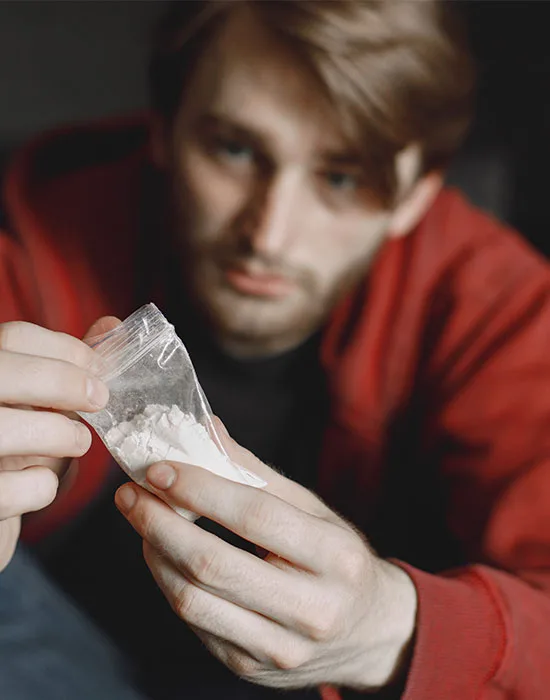Safe, Professional Cocaine Detox in Las Vegas
Cocaine addiction can spiral quickly, affecting your health, relationships, and peace of mind. The first step to recovery is a safe, medically supported detox process. At BetterChoice Treatment Center, we provide compassionate, clinically guided cocaine detox in a private, luxury setting to help you regain control and begin healing.
If you’ve been searching for a trusted cocaine detox center or cocaine detox near me, we’re here to help you take the first step—with expertise, dignity, and 24/7 support.
We Accept All The Major Insurances
Don’t see your insurance provider? Call us for a full list of insurances we accept (725) 299-4777









What Is Cocaine Addiction?
Cocaine addiction is a powerful stimulant use disorder marked by intense cravings, compulsive use, and a cycle of binge and crash. Although the high is short-lived, the urge to use again can quickly spiral out of control. Over time, cocaine impacts brain chemistry, judgment, and emotional stability—making it incredibly difficult to stop without help.
At BetterChoice Treatment Center, our medically monitored cocaine detox program is designed to help individuals safely withdraw, manage psychological symptoms, and take the first step toward long-term sobriety.
Signs of Cocaine Addiction
- Using cocaine frequently, even when alone
- Intense cravings or feeling out of control
- Mood swings, anxiety, or paranoia
- Insomnia or going days without sleep
- Financial problems related to drug use
- Nosebleeds or damaged nasal tissue (if snorting cocaine)
Why Consider Cocaine Detoxification At BetterChoice
Cocaine is a highly addictive stimulant that affects both mind and body. Detoxing on your own can be overwhelming, risky, and often leads to relapse. At BetterChoice Treatment Center, our medically supervised cocaine detox program offers a safe, supportive, and structured environment to help you start your recovery journey with strength and clarity.
Distance Yourself from Triggers
Detoxing in a controlled setting allows you to break free from the environments and influences that contributed to your cocaine use. Being in a drug-free, judgment-free space helps you stay focused on your healing without distractions or temptations.
Higher Success Rate
Detoxing with medical and emotional support greatly increases your chances of success. We offer round-the-clock supervision and therapy to help you manage withdrawal symptoms and avoid early relapse—giving you the best start possible.
Get Personalized Medical Attention
Your recovery plan is tailored to your unique history, symptoms, and needs. Our clinical team monitors your physical and emotional health 24/7, adjusting care as needed to ensure a safe and comfortable detox experience.
Long-term Support System
Cocaine detox is just the first step. Our team helps you transition seamlessly into ongoing rehab, where you’ll receive continued therapy, relapse prevention tools, and a strong aftercare plan for long-term sobriety.
Holistic Treatment Approach
We believe in healing the whole person. In addition to evidence-based therapies, you’ll have access to wellness practices like yoga, mindfulness, and creative therapies that promote balance, reduce anxiety, and build inner strength.
What's Included In Our Program
At BetterChoice Treatment Center, our cocaine detox program is more than just medical support—it’s a structured, compassionate environment designed to help you heal physically, mentally, and emotionally. Here’s what you can expect as part of your care:

Individual Therapy
Work one-on-one with an experienced therapist to address the root causes of your cocaine use, explore personal challenges, and build coping strategies to support long-term recovery.

Group therapy
Recovery is stronger when shared. In group sessions, you’ll connect with others on similar journeys, find peer support, and gain new perspectives through honest, facilitated discussion.

Family Therapy Sessions
Cocaine addiction often causes deep strain on relationships. Our family therapy program helps rebuild trust and improve communication, so your loved ones become allies in your recovery.

24/7 Supervision and Care
Our clinical team is on-site and available around the clock to monitor withdrawal symptoms, manage medical concerns, and provide emotional reassurance at any hour.

Dual Diagnosis
Many struggling with cocaine addiction also face anxiety, depression, or trauma. Our integrated dual diagnosis care treats both the addiction and any co-occurring mental health conditions simultaneously—for deeper, more lasting results.

Lots of Fun Activities
Healing should involve moments of joy, too. Enjoy access to yoga, fitness, art therapy, meditation, and recreation in our serene, luxury environment—designed to support emotional well-being and build healthy routines.
What Is Cocaine Detox?
Understanding Cocaine Detoxification
Cocaine detoxification is the process of allowing the body to clear itself of cocaine while managing withdrawal symptoms in a safe environment. Unlike opioids, cocaine withdrawal is mostly psychological, but it can still be intense, especially for long-term users.
Common symptoms of cocaine withdrawal include:
- Depression and anxiety
- Irritability and agitation
- Fatigue and lack of motivation
- Vivid dreams and insomnia
- Strong drug cravings
- Difficulty concentrating
Our licensed clinicians offer constant monitoring, emotional support, and customized care plans to help you move through detox safely and with the tools to keep moving forward.

Why Medical Cocaine Detox Is Important
Don’t Detox from Cocaine Alone
Cocaine withdrawal may not seem as physically dangerous as detoxing from opioids or alcohol—but it can be emotionally overwhelming and unpredictable. Depression, paranoia, and suicidal thoughts are possible. That’s why professional support is critical.
At BetterChoice Treatment Center, we provide:
- 24/7 clinical supervision
- Emotional and psychological support
- Sleep and mood stabilization strategies
- Nutritional support and hydration therapy
- Private, quiet spaces to rest and recover
- Personalized discharge and aftercare planning
The BetterChoice Detox Experience
Luxury Detox That Puts Your Comfort First
- 198 Ebb Tide Cir, Las Vegas, NV 89123


Our Las Vegas facility is more than just a detox center—it’s a retreat for physical and emotional renewal. Clients detox in a peaceful setting with upscale amenities, compassionate staff, and personalized care.
Amenities Included
- Nutritious, gourmet served meals
- Private or semi-private rooms
- Jacuzzi-equipped bathrooms
- Yoga, sound bath, and holistic wellness therapy, and massage
- Tropical pool, outdoor gardens, and quiet lounges
- Medical supervision 24/7
We’re more than a detox center—we’re a place to feel safe while you begin your new chapter.
What Happens After Cocaine Detox?
Cocaine Detox Is Just the First Step
Cocaine detox removes the drug from your system, but it doesn’t treat the underlying causes of addiction. After detox, we help clients transition into inpatient rehab for comprehensive treatment that addresses emotional trauma, mental health conditions, and long-term sobriety.
Our Rehab Programs Include:
- Cognitive Behavioral Therapy (CBT)
- Trauma-informed therapy
- Dual diagnosis care
- Group therapy and peer support
- Relapse prevention and life skills development

Meet Our Expert Team

Brian Kaszuba
Doctor/Medical Director

Briana Theocharides
Lead Tech/Operational Manager

Jim Jobin
Clinical Director/LCPC

Jamie McAleer
Mental Health Counselor

Wyconda Hopkins
CADC-I

Ani Alvadzhyan
Quality Assurance
Frequently Asked Questions
Is cocaine detox dangerous?
While cocaine withdrawal is typically not life-threatening, it can involve intense psychological symptoms, including depression, anxiety, and suicidal thoughts. That’s why medically supervised detox is important—to ensure safety, emotional stability, and proper care throughout the process.
How long does cocaine detox take?
Cocaine detox usually lasts 5 to 10 days. Most acute symptoms peak within the first week, while lingering fatigue or mood swings may persist for a few weeks. At BetterChoice, we provide full support during and after detox to help manage symptoms and prevent relapse.
What are common symptoms of cocaine withdrawal?
Withdrawal symptoms include:
• Depression or emotional numbness
• Anxiety and restlessness
• Trouble sleeping
• Intense cravings
• Irritability or paranoia
• Physical fatigue
These symptoms can be deeply uncomfortable and discouraging, which is why having medical and emotional support is crucial.
Can I detox from cocaine at home?
Detoxing at home is not recommended. Even though the withdrawal may not seem physically dangerous, psychological symptoms—especially suicidal ideation or panic—can be very serious. At BetterChoice, we ensure your mental and emotional safety with 24/7 monitoring and therapeutic care.
Will I receive medication during detox?
There are no FDA-approved medications specifically for cocaine detox. However, we may prescribe medications to help with anxiety, sleep disturbances, or depression. Your care plan is tailored based on your symptoms and overall health.
What happens after I complete cocaine detox?
After detox, you’ll transition into inpatient rehab to address the emotional and behavioral aspects of addiction. This includes therapy, relapse prevention, and support in rebuilding a healthy lifestyle. Detox alone is not enough to maintain long-term sobriety.
Is cocaine detox covered by insurance?
Yes, many insurance plans cover cocaine detox and addiction treatment. Our admissions team can verify your benefits quickly and confidentially to help you get started without delay.
Cocaine Use & Addiction Statistics
In 2021, approximately 4.8 million people in the U.S. reported using cocaine in the past year.
(Source: National Institute on Drug Abuse – 2021 National Survey on Drug Use and Health)
More than 24,000 overdose deaths in the U.S. involved cocaine in 2021, many also involved synthetic opioids like fentanyl.
(Source: NIDA – Overdose Death Rates)
Cocaine is the second most frequently used illicit drug in the U.S., after marijuana.
(Source: NIDA – DrugFacts: Cocaine, 2023)
Start Cocaine Detox Now
You Deserve a Safe and Supportive Start to Recovery
You don’t have to go through this alone. Whether you’re actively using or just considering the idea of quitting, BetterChoice Treatment Center is here to help.
We offer discreet assessments, fast admissions, and compassionate care every step of the way.
